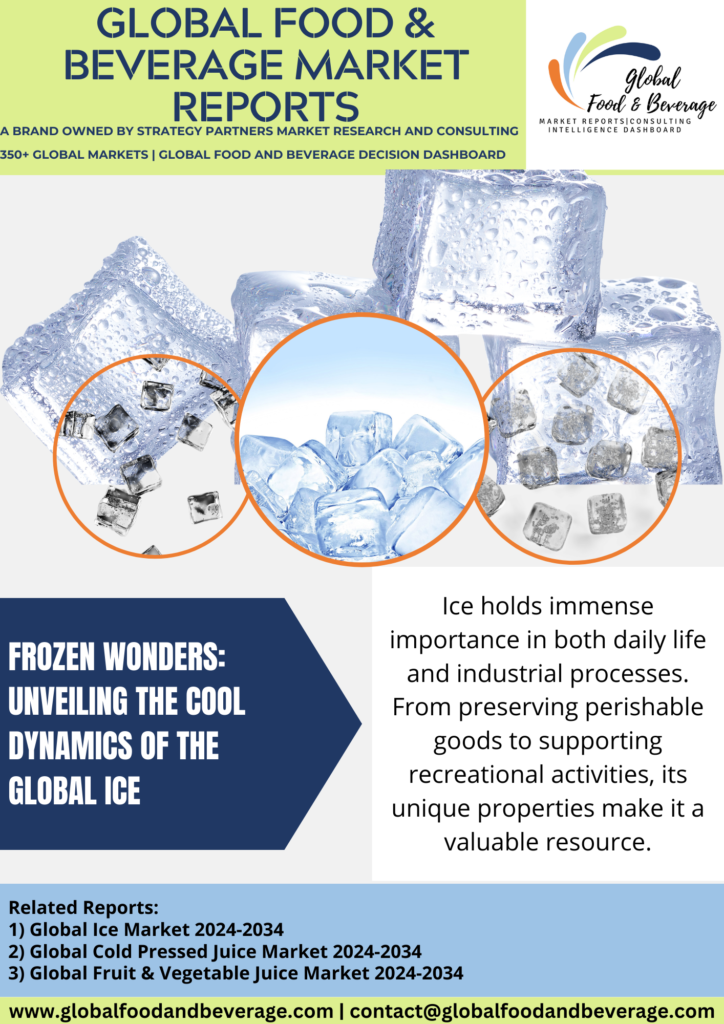Frozen Wonders: Unveiling the Cool Dynamics of the Global Ice Market
Ice, the solid form of water, is a remarkable and versatile substance with a range of practical applications and symbolic significance. Its molecular structure, which arranges water molecules in a hexagonal lattice, gives ice its characteristic crystalline appearance. Ice plays a pivotal role in shaping the Earth’s landscape, from glaciers and icebergs to frost-covered landscapes, influencing both natural and human environments.

One of the most fundamental roles of ice is its contribution to the water cycle. In colder regions, precipitation can fall as snow, and accumulated snowpacks eventually compact and freeze to form glaciers. These massive ice formations slowly move, shaping valleys and carving out landscapes over geological timescales. Icebergs, large pieces of freshwater ice floating in the ocean, are another spectacular result of the freezing process and are particularly associated with polar regions.
On a more practical level, ice is a crucial component in refrigeration and preservation. From keeping perishable foods fresh to preserving vaccines and medications, ice plays a vital role in modern life. Ice cubes are a staple in households worldwide, used to cool beverages and provide relief from the heat during warmer seasons.
Recreationally, ice serves as the foundation for various winter sports and activities. Ice skating, ice hockey, and curling are just a few examples of sports that rely on the frozen surface of lakes, ponds, or specially designed rinks. The unique allure of ice extends to artistic pursuits like ice sculpting and figure skating, where skilled individuals transform solid blocks of ice into intricate designs or showcase graceful movements on frozen surfaces.
Symbolically, ice can represent both beauty and danger. While a delicate frost on leaves or windows can create a picturesque winter scene, icy conditions on roads and walkways pose risks to transportation and pedestrian safety. The duality of ice, with its potential for both enchantment and hazard, underscores the complex nature of this seemingly simple substance.
ADVANCEMENTS
While ice may seem like a simple and ubiquitous substance, recent advancements in ice-related technologies and applications have contributed to various industries. One significant breakthrough is the development of clear or “artisanal” ice. Utilizing specialized freezing techniques and purified water, producers create ice with fewer impurities, resulting in crystal-clear cubes. This innovation caters to the preferences of cocktail enthusiasts and upscale establishments where ice clarity is valued for aesthetic and functional reasons.
In the field of refrigeration, advancements in ice-making machines have led to increased efficiency, reduced energy consumption, and improved ice production capacities. Smart technologies and automation allow for precise control over ice production, ensuring a steady supply without wastage.
In the medical field, advancements in cryotherapy involve the use of ice for therapeutic purposes. From targeted cold therapies for injury recovery to whole-body cryotherapy chambers, the application of controlled cold temperatures is expanding, with potential benefits for pain management, inflammation reduction, and overall well-being.
The development of flavored and functional ice cubes reflects innovations in the beverage industry. These ice cubes are infused with natural flavors, herbs, or even electrolytes, enhancing the drinking experience. This trend aligns with the growing demand for customizable and enhanced beverages.
Ice artistry has emerged as a unique form of culinary expression. Sculptors and chefs use advanced carving techniques and molds to create intricate and visually stunning ice sculptures for events, showcasing the artistic potential of this frozen medium.
Advancements in ice storage and transportation technologies contribute to the preservation and delivery of perishable goods, especially in the food and healthcare industries. Improved insulation materials and refrigeration methods ensure that ice remains a reliable means of preserving temperature-sensitive products during transit.
CHALLENGES
The ice industry faces challenges ranging from production and distribution to market competition and environmental concerns. One significant challenge is ensuring a stable and efficient supply chain for ice production and distribution. The perishable nature of ice and the need for controlled storage conditions demand effective logistics to prevent product deterioration and ensure timely delivery to consumers.
Market competition in the ice industry is intense, with various ice products and forms available in the market. Successfully differentiating products, addressing diverse consumer preferences, and maintaining a competitive edge require continuous innovation in packaging, sizes, and marketing strategies.
Regulatory compliance poses challenges, especially concerning food safety standards and packaging regulations. Adhering to diverse regulations across regions or countries demands continuous diligence to ensure transparency and compliance with evolving standards.
Environmental concerns related to water usage and energy consumption in ice production are emerging challenges. Implementing sustainable practices, such as water recycling and energy-efficient technologies, is crucial for reducing the environmental impact of ice production.
Technological advancements and changing consumer preferences contribute to challenges in the ice industry. Innovations in ice-making technologies and the development of alternative cooling methods require adaptation and investment to stay competitive and meet evolving market demands.
Consumer education is vital for promoting the quality and safety of ice products. Effectively communicating the importance of using safe and properly produced ice for various applications, including food and beverages, is essential for building consumer awareness and trust.
CONCLUSION
Ice stands as both a humble necessity and a versatile marvel, shaping culinary, recreational, and industrial landscapes. From refreshing beverages to preserving perishables, its significance is ubiquitous. As global perspectives on sustainability evolve, so does the exploration of alternative uses for ice in refrigeration and beyond. The frozen water’s transformative role in mixology and culinary arts underscores its dynamic potential. While traditional ice remains an elemental force, innovations like artisanal shapes and crystal-clear cubes redefine its aesthetic contribution. The future holds a fascinating intersection of tradition and innovation, where the simple essence of frozen water continues to weave its multifaceted influence across diverse domains.
